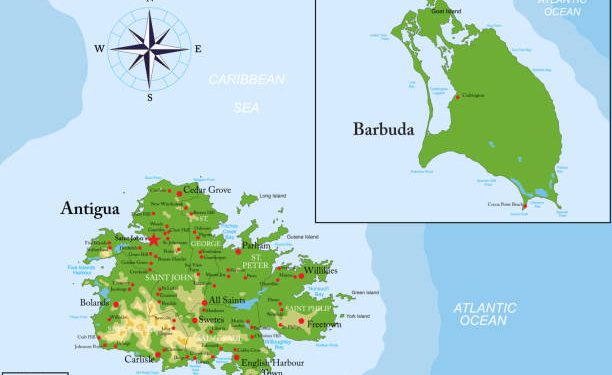The Beginning of a New History
When Europeans and Africans entered upon Antigua and Barbuda soil in 1632, the lopsided arrangement that was replicated in other English-speaking British territories would be repeated in Britain’s newest colony. The indigenous people of the Caribbean would have been chased off the land; the African peoples imported against their will would become chattel and slaves; the Europeans would remain the only owners of the real estate that was now deemed the property of the Crown.
Sugarcane and other agricultural crops formed the basis of wealth-creation, driven by the enslavement of human imports from all across the African continent. That system of exclusive land ownership and decisions about what to grow, were the exclusive domain of the European masters. In 1807, the British brought an end to the trade in humans; and in 1834, decreed the end of enslavement of humans within the British dominions.
The people of African descent, who comprised the majority population in Antigua and Barbuda, remained extremely poor and illiterate throughout the 200 years of enslavement; they continued living in abject poverty for another century. The church, agitation by civic groups, and eventually the trade union movement, began to change the prevailing circumstances. On 20 December 1939, the Trades Union Act was adopted, allowing for collective bargaining, and for strikes by workers to take place. In 1939, the beginning of a velvet revolution and a new history began to unfurl.
The Modern History of Antigua and Barbuda
The people of Antigua and Barbuda remained forlorn and downtrodden until the trade union movement ignited a fearlessness that had been subdued for generations—especially following their unsuccessful 1736 attempt to bring an end to the majority’s subjugation. Fear and hopelessness were ingrained in the population of people who lived through oppression for three hundred years.
Along came Vere Cornwall Bird, a daring Salvation Army preacher, imbued with the nationalist sentiment of Marcus Garvey, who came to believe that all civilization was created by the thoughts of men. Caribbean civilization, the black prophet preached and the new leaders learned, could be altered by those who had the courage to change their circumstances through leadership. God would seek to lead the Caribbean people by causing their leaders to strike out on new paths.
Between 1939 and 1967, a second period of 28 years, the alteration of the circumstances of the majority population began to change in myriad ways. The trade union movement oversaw the introduction of government-controlled primary education; free secondary education; elective government; constitutional advances; increase in wages and better conditions of work; economic opportunities for entrepreneurs; new wealth-creation methods; the switch from sugarcane to tourism; superior housing; improved healthcare; longer life and better diets; ownership possibilities that saw a diversification of wealth-creation to include those entrepreneurs of African descent. The erosion of the colour barrier, and the upliftment of the entire Caribbean civilization by regional collaboration, was brought about by the trade union movement and its political arm. In this writer’s view, the most telling change in circumstances occurred on 7 April 1967.
The Purchase of the Antigua Sugar Factory/Antigua Syndicates Estates: LAND AND BUSINESS
Although constitutional changes on 27 February 1967 placed Antigua and Barbuda on the road to becoming an independent and sovereign state, the issue of economic survivability bedeviled even the smartest economists and thinkers of the period. How could a small island-state of 80,000 souls hope to become viable following a centuries-old history of exploitation, export of capital, and the freedom of its people to move to other places?
Ownership of the land was the answer, though it was not expressly so stated. On 7 April 1967, when the people of Antigua and Barbuda became the owners of the lands on which their forebears slaved, succumbed and died poor, they began to build the New Jerusalem.
The Sugar Factory had been unable to repay a loan from the Royal Bank of Canada when the bank demanded payment. It was declared a bankrupt, and its assets were put up for sale. A government eager to access land and to re-shape a 300-year old history was led by a visionary who sought to change the circumstances of his people: Laws of Antigua CAP 240 (30th December 1969):
SECOND SCHEDULE
THIS AGREEMENT is made the 7th day of April, One thousand nine hundred and sixty-seven BETWEEN THE ANTIGUA SUGAR FACTORY LIMITED the registered office of which is situate at 5, Laurence Pountney Hill, London E.C.4. (hereinafter called “the Factory”) of the first part ANTIGUA SYNDICATE ESTATES LIMITED the registered office of which is situate in Antigua (hereinafter called “Estates”) of the second Part JAMES MACINDOE WATSON of Gunthorpes Antigua (hereinafter called “the Receiver”) of the Third Part and THE HONOURABLE VERE CORNWALL BIRD The Premier and Finance Minister of Antigua for and on behalf of the Government of Antigua (hereinafter called “the Government”) of the fourth part.
- (A) THE total consideration to be paid by the Government for the assets of the Factory and Estates as set out in Clauses 1 and 2 hereof shall be E.C. $5,621,386.80which as between the Factory and Estates shall be apportioned as to E.C. $2,621,386.80 to the assets of the Factory as set out in Clause 1 hereof and as to E.C. $3,000,000 to the assets of Estates as set out in Clause 2 hereof.
This single Act changed the circumstances forever. Ownership of the land was now securely in the hands of the people, and the possibilities thereafter were endless.



